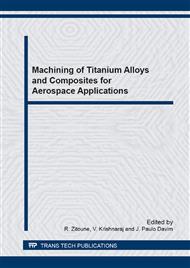p.1
p.29
p.51
p.65
p.91
p.107
p.127
p.145
Experimental Study on Tool Wear when Machining Super Titanium Alloys: Ti6Al4V and Ti-555
Abstract:
To understand the effect of the workpiece microstructure on the tool wear behavior, anexperimental investigation was conducted on machining two different microstructures of supertitanium alloys: Ti-6Al-4V and Ti-555. The analysis of tool-chip interface parameters such asfriction, heat flux and temperature rise and the evolution of the workpiece microstructure underdifferent cutting conditions have been discussed. As cutting speed and feed rate increase, the meancutting forces and temperature show different progressions depending on the consideredmicrostructure. Results show that wear modes for cutting tools used in machining the Ti-555 alloyshow contrast from those exhibited by tools used in machining the Ti6AI4V alloy. In fact, onlyabrasion wear was observed for cutting tools in the case of machining the near-β titanium Ti-555alloy. The last alloy is characterized by a fine-sized microstructure (order of 1 μm). For the usualTi6Al4V alloy, adhesion and diffusion modes followed by coating delamination process on the toolsubstrate have been clearly identified. Moreover, a deformed layer was observed under secondaryelectron microscope (SEM) from the sub-surface of the chip with β-grains orientation along thechip flow direction. The analysis of the microstructure confirms the intense deformation of themachined surface and shows a texture modification, without phase transformation. For the Ti-555β-alloy, β grains experiences more plastic deformation and increases the microhardness of theworkpiece inducing then an abrasion wear process for cemented carbide tools. For the Ti6Al4Vmicrostructure, the temperature rise induces a thermal softening process of the workpiece andgenerates adhesive wear modes for cutting tools. The observed worn tool surfaces confirm theeffect of the microstructure on tool wear under different cutting conditions for the two studiedtitanium alloys.
Info:
Periodical:
Pages:
51-64
Citation:
Online since:
July 2013
Authors:
Keywords:
Price:
Сopyright:
© 2013 Trans Tech Publications Ltd. All Rights Reserved
Share:
Citation:


